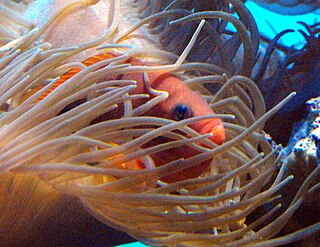 W
WAmphiprion is a genus of ray-finned fish which comprises all but one of the species of clownfish or anemonefish in the subfamily Amphiprioninae of the family Pomacentridae.
 W
WThe cleftbelly trevally, also known as the cleftbelly kingfish, Kuweh trevally or thin crevalle, is a species of tropical marine fish of the jack family, Carangidae. The species inhabits coastal waters throughout the Indo-West Pacific region from South Africa in the west to Japan in the east, often found near the water's surface. The cleftbelly trevally is the only member of the genus Atropus and is distinguished by a number of anatomical characteristics, with a deep median groove in the belly giving the species its common name. It is not a large fish, growing to a maximum recorded length of 26.5 cm. Cleftbelly trevally are predatory fish, taking a variety of small crustaceans and fish. The species is of minor importance to fisheries throughout its range.
 W
WSchneider's leaf-nosed bat or Schneider's roundleaf bat is a species of bat in the family Hipposideridae. It is endemic to South Asia. Its natural habitats are subtropical or tropical dry forests, caves, and urban areas.
 W
WBoiga trigonata, commonly known as the Indian gamma snake or common cat snake, is a species of rear-fanged colubrid endemic to South Asia.
 W
WCerberus rynchops, also known as the New Guinea bockadam, South Asian bockadam, bockadam snake, or dog-faced water snake, is a mildly venomous species of a snake in the family Homalopsidae. It is native to coastal waters of South and Southeast Asia. The species was re-delimited in 2012, allocating populations east and south of the west coast of Thailand to other species.
 W
WA viperfish is any species of marine fish in the genus Chauliodus. Viperfish are characterized by long, needle-like teeth and hinged lower jaws. A typical viperfish grows to lengths of 30 to 60 cm. Viperfish stay near lower depths in the daytime and shallower depths at night, primarily in tropical and temperate waters. Viperfish are believed to attack prey after luring them within range with light-producing organs called photophores, which are located along the ventral sides of its body, and with a prominent photophore at the end of a long spine in the dorsal fin reminiscent of the illicium of the unrelated deepsea anglerfishes. The viperfish flashes this natural light on and off, at the same time moving its dorsal spine around like a fishing rod and hanging completely still in the water. It also uses the light producing organ to communicate to potential mates and rivals.
 W
WThe checkered keelback, also known commonly as the Asiatic water snake, is a common species of non venomous snake in the subfamily Natricinae of the family Colubridae. The species is endemic to Asia.
 W
WCichla ocellaris, sometimes known as the butterfly peacock bass, is a very large species of cichlid from South America, and a prized game fish. It reaches 74 cm (29 in) in length. It is native to the Marowijne and Essequibo drainages in the Guianas, and the Branco River in Brazil. It has also been introduced to regions outside its natural range, but some uncertainty exists over the exact identity, and at least some of the introductions may involve another Cichla species or hybrids. It is frequently confused with C. monoculus.
 W
WEchis carinatus is a venomous viper species found in parts of the Middle East and Central Asia, and especially the Indian subcontinent. It is the smallest member of the big four snakes that are responsible for causing the most snakebite cases and deaths, due to various factors including their frequent occurrence in highly populated regions, and their inconspicuous nature. Five subspecies are currently recognized, including the nominate subspecies described here.
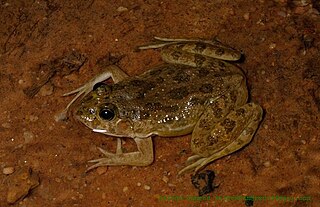 W
WEuphlyctis cyanophlyctis is a common dicroglossid frog found in South Asia. It is known under numerous common names, including Indian skipper frog or skittering frog. They are often seen at the edge of bodies of water with their eyes above the water. They noisily move away from the shore when disturbed, giving them their common name. They are rarely seen outside water.
 W
WEutropis carinata, the keeled Indian mabuya, many-keeled grass skink or (ambiguously) "golden skink", is a species of skink found in South Asia.
 W
WThe Florida softshell turtle is a species of softshell turtle native to the Southeastern United States.
 W
WGongylophis conicus, also known as Russell's boa or the rough-scaled sand boa, is a species of nonvenomous snake in the subfamily Erycinae of the family Boidae. The species is endemic to India, Nepal, Bangladesh, Pakistan and Sri Lanka. There are no subspecies which are recognised as being valid.
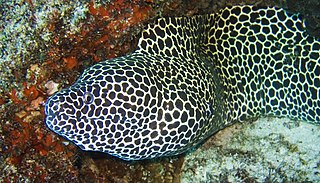 W
WThe laced moray, also known as the leopard moray, tessellate moray or honeycomb moray, is a species of marine fish in the family Muraenidae.
 W
WLithodytes is a genus of frogs in the family Leptodactylidae. It is monotypic, being represented by the single species, Lithodytes lineatus, the gold-striped frog or painted antnest frog. It is found in tropical South America where it lives in humid forests among the leaf litter. These frogs build foam nests at the edge of temporary pools, and the tadpoles develop within these. The frogs also associate with certain leafcutter ants and breed inside their nests without being attacked by the ants.
 W
WMonocentris is a genus of pinecone fishes native to the Indian and Pacific Oceans.
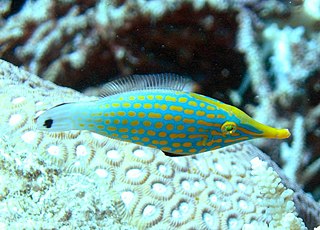 W
WThe orange spotted filefish or harlequin filefish, Oxymonacanthus longirostris, is a filefish in the family Monacanthidae found on coral reefs in the Indo-Pacific Oceans. The orangespotted filefish is a different species and refers to Cantherhines pullus.
 W
WPeacock bass (Cichla) is a genus of large cichlids, diurnal and predatory freshwater fish native to the Amazon and Orinoco basins, as well as rivers of the Guianas, in tropical South America. They are sometimes referred to in English by their Brazilian name tucunaré or their Spanish name pavon. Despite the common name and their superficial similarity, they are not closely related to other fish known as bass, such as the North American largemouth bass.
 W
WThe broad-headed skink or broadhead skink is species of lizard, endemic to the southeastern United States.
 W
WPoecilia is a genus of fishes in the family Poeciliidae Poecculent of the order Cyprinodontiformes. These livebearers are native to fresh, brackish and salt water in the Americas, and some species in the genus are euryhaline. A few have adapted to living in waters that contain high levels of toxic hydrogen sulfide and a population of P. mexicana lives in caves.
 W
WPseudolabrus miles, the scarlet wrasse, is a species of wrasse endemic to the waters around New Zealand. It is an inhabitant of reefs where it can be found at depths of from 4 to 40 metres, though usually deeper than 10 metres (33 ft). Males of this species can reach a length of 27.2 centimetres (10.7 in) SL while females are slightly smaller at 26.9 centimetres (10.6 in).
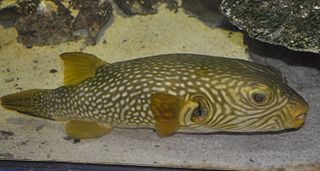 W
WArothron reticularis, variously known as the reticulated pufferfish, reticulated blowfish or reticulated toadfish, is a ray-finned fish in the family Tetraodontidae. It is native to the tropical and sub-tropical Indo-Pacific region where its habitats include sandy and muddy seabeds, coral reefs, estuaries and mangrove areas.
 W
WThe queen parrotfish is a species of marine ray-finned fish, a parrotfish, in the family Scaridae. It is found on reefs in the tropical West Atlantic Ocean and the Caribbean Sea. Other common names include blownose, blue chub, blue parrotfish, blueman, joblin crow parrot, moontail, okra peji and slimy head. The young males and adult female queen parrotfish are a reddish-brown color, and quite different in appearance from the bluish-green color of the final phase male. This is a common species throughout its range and the International Union for Conservation of Nature has rated its conservation status as "least concern".
 W
WRhina ancylostoma, the bowmouth guitarfish, shark ray or mud skate, is a species of ray and a member of the family Rhinidae. Its evolutionary affinities are not fully resolved, though it may be related to true guitarfishes and skates. This rare species occurs widely in the tropical coastal waters of the western Indo-Pacific, at depths of up to 90 m (300 ft). Highly distinctive in appearance, Rhina ancylostoma has a wide and thick body with a rounded snout and large shark-like dorsal and tail fins. Its mouth forms a W-shaped undulating line, and there are multiple thorny ridges over its head and back. It has a dorsal color pattern of many white spots over a bluish gray to brown background, with a pair of prominent black markings over the pectoral fins. This large species can reach a length of 2.7 m (8.9 ft) and weight of 135 kg (298 lb).
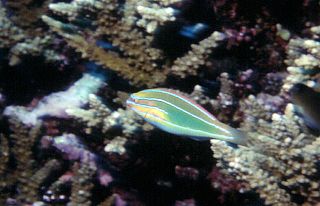 W
WStethojulis trilineata, also known as the blue-ribbon wrasse, red shouldered rainbow-fish, scarlet-banded rainbowfish, three-blueline wrasse, three-lined rainbowfish or three-lined wrasse, is a species of marine ray-finned fish, a wrasse from the family Labridae. It is found in the Indo-Pacific region where it is associated with reefs.
 W
WSynanceia is a genus of fish of the family Synanceiidae, the stonefish, whose members are venomous, dangerous, and even fatal to humans. They are the most venomous fish known. They are found in the coastal regions of the Indo-Pacific.
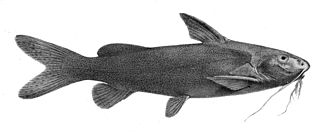 W
WSynodontis schall, the Wahrindi, is a species of upside-down catfish widespread in northern Africa. This species is in the largest genus of the family Mochokidae. This species grows to a length of 49.0 centimetres (19.3 in) TL.
 W
WTiliqua gigas is a close relative of the Eastern blue-tongued lizard. They are endemic to the island of New Guinea and other various surrounding islands. They are found typically in the rainforest, and in captivity, require high humidity. As opposed to Tiliqua scincoides, they are fairly lean. They're also accompanied by long tails. There are currently three subspecies of Tiliqua gigas. First subspecies to be recognized is Tiliqua gigas gigas, in which are simply called the Indonesian blue-tongued skink. The second subspecies is Tiliqua gigas keyensis, typically called the Kei island blue-tongued skink. Lastly, there is Tiliqua gigas evanescens, which is called the Merauke blue-tongued skink.
 W
WThe cleftbelly trevally, also known as the cleftbelly kingfish, Kuweh trevally or thin crevalle, is a species of tropical marine fish of the jack family, Carangidae. The species inhabits coastal waters throughout the Indo-West Pacific region from South Africa in the west to Japan in the east, often found near the water's surface. The cleftbelly trevally is the only member of the genus Atropus and is distinguished by a number of anatomical characteristics, with a deep median groove in the belly giving the species its common name. It is not a large fish, growing to a maximum recorded length of 26.5 cm. Cleftbelly trevally are predatory fish, taking a variety of small crustaceans and fish. The species is of minor importance to fisheries throughout its range.
 W
WTrichogaster is a genus of gouramis native to South Asia from Pakistan to Myanmar. It is the only genus in the monotypic subfamily Trichogastrinae as set out in the 5th Edition of Fishes of the World, although that book states that there are two genera, the other being Colisa which is treated as a synonym of Trichogaster by Fishbase and the Catalog of Fishes. Fishbase also places the genus in the Luciocephalinae. Species of this genus are very popular in the aquarium trade.
 W
WTrichogaster fasciata, the banded gourami or striped gourami or giant gourami, is a tropical labyrinth perch found in some Asian countries like Bangladesh, Eastern India, Northeastern India, Nepal, Upper Myanmar, China and Pakistan.
 W
WTrichonotus is a genus of marine gobiiform fishes. Species of Trichonotus are distributed throughout the Indo-West Pacific. This genus is the only member of the family Trichonotidae.
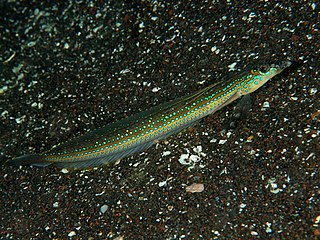 W
WThe spotted sand-diver is a perciform fish in the family Trichonotidae. T. setiger is the type species of genus Trichonotus.
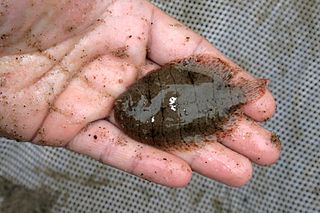 W
WThe hogchoker is a small flatfish found along the Atlantic coast of North America, ranging from Massachusetts and Florida to Panama. They prefer brackish water, and are abundant in many bays and estuaries north of the Carolinas. It is a member of the American sole family Achiridae. They are usually brown to dark brown in color, and lighter on their "blind side". The overall body color is often broken by a series of spots and thin stripes, which can be lighter or darker than the main body color. The fins and tail have fringed edges helping hide the fish from its prey. They mainly feed on small aquatic insects and invertebrates. They are regarded as "trash fish" by recreational fishermen and were fed to pigs but they have rather bony bodies which were sometimes difficult for the pigs to swallow, hence the vernacular name.
 W
WWallago attu is a freshwater catfish of the family Siluridae, native to South and Southeast Asia. It is commonly known as helicopter catfish or wallago catfish. Some regional designations, such as the Manipuri Sareng, the Bengal Boal, the Sylheti Gual or the Malaysian and Indonesian Tapah are also occasionally used in English. W. attu is found in large rivers and lakes in two geographically disconnected regions, with one population living over much of the Indian Subcontinent and the other in parts of Southeast Asia. The species can reach a total length of 1 m.